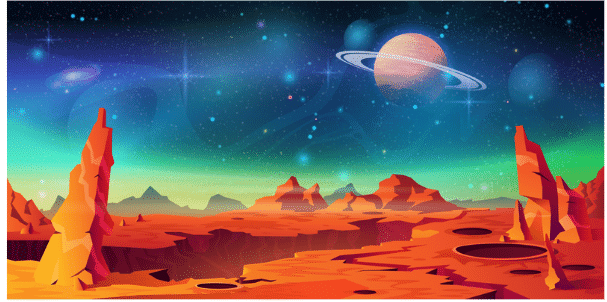Our Universe - 1 Class 3 Worksheet SST

Q1: Multiple Choice Questions (MCQs)
1. What is the name of our galaxy?
a) Andromeda
b) Milky Way
c) Solar System
d) Universe
Ans: b) Milky Way
2. Which planet is known as the "Red Planet"?
a) Earth
b) Jupiter
c) Mars
d) Saturn
Ans: c) Mars
3. What is the largest planet in our solar system?
a) Mercury
b) Jupiter
c) Venus
d) Neptune
Ans: b) Jupiter
4. What causes day and night on Earth?
a) The revolution of the Earth
b) The rotation of the Earth
c) The movement of the Moon
d) The heat from the Sun
Ans: b) The rotation of the Earth
5. How many planets are there in our solar system?
a) Seven
b) Eight
c) Nine
d) Ten
Ans: b) Eight
Q2: Match the following

Ans: 
Q3: True or False
1. The universe is small and has only a few stars.
Ans: False
The universe is huge and endless. It has billions of stars, planets, and galaxies.
2. The Earth is the only planet in the solar system that has life.
Ans: True
3. The Sun is bigger than all the planets in the solar system.
Ans: True
4. There are ten planets in the solar system.
Ans: False
There are eight planets in the solar system. The eight planets are Mercury, Venus, Earth, Mars, Jupiter, Saturn, Uranus, and Neptune.
5. The Earth takes 365 days to complete one revolution around the Sun.
Ans: True
Q4: Answer the following Questions
1. What is the universe?
Ans: The universe is everything around us, including stars, planets, galaxies, and all matter and energy.
2. Why is Earth special?
Ans: Earth is special because it is the only planet known to have life.
3. What is a galaxy?
Ans: A galaxy is a large group of stars, dust, and gas held together by gravity.
4. How does the Earth move around the Sun?
Ans: The Earth moves around the Sun in a fixed path called an orbit, taking 365 days to complete one full revolution.
5. What is the function of the Sun?
Ans: The Sun provides light and heat, making life possible on Earth.
Q5: Imagine and Write
If you could visit any planet in our solar system, which one would you choose and why? Write 3-4 sentences.
Ans: I would like to visit Mars because it is called the Red Planet and looks very different from Earth. Scientists are trying to find out if life ever existed on Mars, and I would love to explore it. I want to see its big mountains, dusty land, and huge craters. It would be fun to jump and walk on Mars in a space suit like an astronaut!

FAQs on Our Universe - 1 Class 3 Worksheet SST
| 1. What is the Big Bang theory? |  |
| 2. How was the age of the universe determined? |  |
| 3. What is dark matter and why is it important in understanding the universe? |  |
| 4. What is dark energy and how does it affect the expansion of the universe? |  |
| 5. What is the significance of cosmic inflation in the early universe? |  |






















